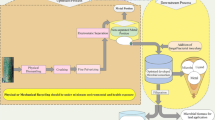Abstract
In this paper, utilizing the existing primary copper smelter process for the recovery of metals from waste printed circuit boards (PCBs) is proposed as an alternative to the current backyard operations in developing countries. The Model for Evaluating Metal Recycling Efficiency from Complex Scraps (MEMRECS) concept is introduced as a tool for the evaluation of the eco-efficiency of metals recovery from waste PCBs. Based on the MEMRECS approach, the relative contribution of every metal fraction to the recyclability of the whole product is estimated. Thereby, gold content is identified as a key factor strongly influencing the efficiency of metals recovery from waste PCBs. Furthermore, it could be used as an indicator for the categorization of waste PCBs before feeding them into the recycling process. Finally, an integrated process is proposed to optimize the eco-efficiency of metals recovery from waste PCBs in developing countries.



Similar content being viewed by others
References
Le HL, Jeong J, Lee JC, Pandey BD, Yoo JM, Huynh TH (2011) Hydrometallurgical process for copper recovery from waste printed circuit boards (PCBs). Miner Process Extr Metall Rev 32(2):90–104
Hagelüken C (2006) Improving metal returns and eco-efficiency in electronic recycling—a holistic approach for interface optimisation between pre-processing and integrated metals smelting and refining. In: Proceedings of the 2006 IEEE international symposium on electronics and the environment, San Francisco, California, 8–11 May 2006. IEEE, pp 218–223
Brentrup F, Küsters J, Kuhlmann H, Lammel J (2004) Environmental impact assessment of agricultural production systems using the life cycle assessment methodology: I. Theoretical concept of a LCA method tailored to crop production. Eur J Agron 20:247–264
Burger E, Hinterberger F, Giljum S, Manstein C (2009) When carbon is not enough: comprehensive ecological rucksack indicators for products. Presented at the R’09 Twin World Congress, Davos, Switzerland, 14–16 September 2009. Available online at: http://old.seri.at/documentupload/SERI%20PR/burger_davos_r09_14.09.09.pdf
Le HL, Yamasue E, Okumura H, Ishihara KN (2013) Model for evaluating metal recycling efficiency for complex scraps (MEMRECS) and its calculations with different life cycle impact assessment methods. Int J Arts Sci 6:73–87
Le HL, Ishihara KN, Yamasue E, Okumura H (2013) Assessment of metal recovery efficiency for waste printed circuit boards in Vietnam with MEMRECS and different end-of-life scenarios. In: Proceedings of the 28th international conference on solid waste technology and management, Philadelphia, Pennsylvania, 10–13 March 2013
Le HL, Yamasue E, Okumura H, Ishihara KN (2013) MEMRECS—a sustainable view for metal recycling from waste printed circuit boards. J Environ Prot 4:803–810
Kalimo H (2006) E-cycling: linking trade and environmental law in the EC and the U.S. Transnational Publishers, Ardsley, pp 251–262
Legarth JB, Alting L, Danzer B, Tartler D, Brodersen K, Scheller H, Feldmann K (1995) A new strategy in the recycling of printed circuit boards. Circuit World 21(3):10–15
Huisman J, Boks CB, Stevels ALN (2003) Quotes for environmentally weighted recyclability (QWERTY): concept of describing product recyclability in terms of environmental value. Int J Prod Res 41:3649–3665
Huang J (2008) Combining entropy weight and TOPSIS method for information system selection. In: Proceedings of the 2008 IEEE conference on cybernetics and intelligent systems, Chengdu, China, 21–24 September 2008, pp 1281–1284. doi:10.1109/ICCIS.2008.4670971
Huisman J (2003) The QWERTY/EE concept, quantifying recyclability and eco-efficiency for end-of-life treatment of consumer electronic products. Dissertation, Delft University of Technology
Hagelüken C (2005) Recycling of electronic scrap at Umicore’s integrated metals smelters and refinery. In: Proceedings of the 2005 electronic materials conference, Santa Barbara, California, 22–24 June 2005
Giurco D, Stewart M, Suljada T, Petrie J (2006) Copper recycling alternatives: an environmental analysis. In: Proceedings of the 5th annual environmental engineering research event, Noosa, Queensland, Australia, 20–23 November 2001
Park YJ, Fray DJ (2009) Recovery of high purity precious metals from printed circuit boards. J Hazard Mater 164:1152–1158
Yamane LH, de Moraes VT, Espinosa DCR, Tenório JAS (2011) Recycling of WEEE: characterization of spent printed circuit boards from mobile phones and computers. Waste Manag 31:2553–2558
Goedkoop M, Spriensma R (2000) The Eco Indicator’99, a damage-oriented method for life cycle impact assessment. Final report, National Reuse of Waste Research Program. PRé Consultants, Amersfoort, the Netherlands
Classen M, Althaus H-J, Blaser S, Tuchschmid M, Jungbluth N, Doka G, Faist Emmenegger M, Scharnhorst W (2009) Life cycle inventories of metals. Final report ecoinvent data v2.1, No 10. EMPA Dübendorf, Swiss Centre for Life Cycle Inventories, Dübendorf, CH. http://www.ecoinvent.ch
U.S. Geological Survey (2012) Mineral commodity summaries 2012. U.S. Geological Survey
Kasper AC, Berselli GBT, Freitas BD, Tenório JAS, Bernardes AM, Veit HM (2011) Printed wiring boards for mobile phones: characterization and recycling of copper. Waste Manag 31:2536–2545
Hagelüken C (2007) Metals recovery from e-scrap in a global environment. Technical capabilities, challenges & experience gained. 6th session of the OEWG Basel Convention, Geneva, Switzerland, 7 September 2007
Acknowledgments
This work was partly supported by an “Energy Science in the Age of Global Warming” Global Center of Excellence (G-COE) program (J-051) of the Ministry of Education, Culture, Sports, Science and Technology of Japan.
Author information
Authors and Affiliations
Corresponding author
Rights and permissions
About this article
Cite this article
Le, HL., Yamasue, E., Okumura, H. et al. Improving sustainable recovery of metals from waste printed circuit boards by the primary copper smelter process. J Mater Cycles Waste Manag 16, 298–305 (2014). https://doi.org/10.1007/s10163-013-0189-7
Received:
Accepted:
Published:
Issue Date:
DOI: https://doi.org/10.1007/s10163-013-0189-7




